Purchasing Management: Supplier Selection, Costs, and ICT at Giti Tire
VerifiedAdded on 2019/10/30
|12
|3133
|145
Report
AI Summary
This report provides a comprehensive analysis of purchasing management practices at Giti Tire Private Limited, a global tire manufacturing company. It explores three key aspects: supplier selection criteria, purchasing costs, and the utilization of Information and Communication Technology (ICT). The report begins by outlining Giti Tire's goals, strategies, and the competitive landscape. It then delves into supplier selection, discussing various criteria, associated issues, and the importance of cost-based supplier selection. The report recommends strategies like identifying suppliers through stakeholder suggestions, measuring supply outcomes, acquiring supplier feedback, and developing partnerships. It also examines the impact of ICT on purchasing operations, suggesting the adoption of e-sourcing equipment, computerized tracking, and social media integration. Finally, the report analyzes purchasing costs, emphasizing the importance of cost analysis, inventory analysis, supplier consolidation, maverick spending control, and delivery time analysis. The report recommends the use of tools like Total Cost Ownership (TCO) and Activity-Based Costing (ABC) for effective cost management. Overall, the report provides actionable insights and recommendations for optimizing purchasing management at Giti Tire.
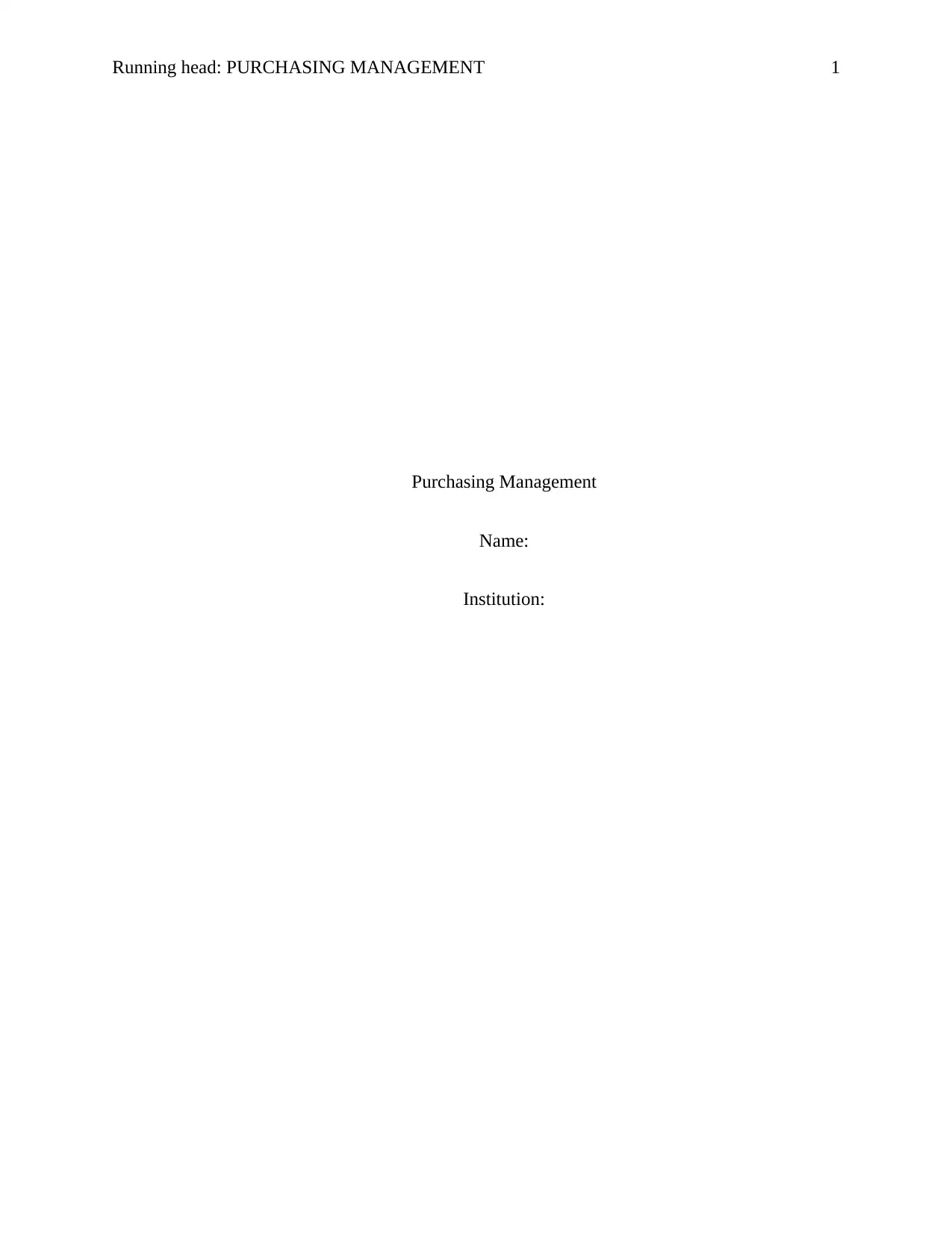
Running head: PURCHASING MANAGEMENT 1
Purchasing Management
Name:
Institution:
Purchasing Management
Name:
Institution:
Paraphrase This Document
Need a fresh take? Get an instant paraphrase of this document with our AI Paraphraser

Purchasing Management 2
Introduction
This Paper aims to explore the effectiveness of three aspects of the purchasing
management which are the supplier selection criteria, the purchasing costs, and the use of
information and communication technologies, the ICT. The purchasing management involves the
buying of the spare parts, services, and the raw materials for the selected organization
(Miemczyk, Johnsen &Macquet, 2012). For this paper, Giti Tire Private Limited which is a
manufacturing company in Singapore is considered. As a purchasing manager in Giti Tire
Private Limited, I will analyze all the aspects of the purchasing process involved in the company.
The purchasing procedures differ from one company to another though there are some similar
factors starting from the demand and other requirements. The Giti Tire Private Limited is a
global organization which engages in manufacturing of tires, has about 3200 employees, and
distributes its products to about 130 nations. The company faces stiff competition from various
organizations such as Dextero, Runway, and Primewell which also won the awards based on tire
production. The significant goal for the company is to focus on the customers, to listen, watch,
and also learn. On the other hand, the strategies for Giti Tire Private Limited involve delivering
excellence and exceed the customers’ expectations to maintain and attract more customers, as
well as increase the sales globally.
Supplier Selection and issues
In analyzing the purchasing goals of Giti Tire Private Limited, it aims to establish,
manufacture, and sell the tires and the related products to various parts of the world such as the
United States, Europe, Indonesia, China, and others. Some of the purchasing needs are that the
Introduction
This Paper aims to explore the effectiveness of three aspects of the purchasing
management which are the supplier selection criteria, the purchasing costs, and the use of
information and communication technologies, the ICT. The purchasing management involves the
buying of the spare parts, services, and the raw materials for the selected organization
(Miemczyk, Johnsen &Macquet, 2012). For this paper, Giti Tire Private Limited which is a
manufacturing company in Singapore is considered. As a purchasing manager in Giti Tire
Private Limited, I will analyze all the aspects of the purchasing process involved in the company.
The purchasing procedures differ from one company to another though there are some similar
factors starting from the demand and other requirements. The Giti Tire Private Limited is a
global organization which engages in manufacturing of tires, has about 3200 employees, and
distributes its products to about 130 nations. The company faces stiff competition from various
organizations such as Dextero, Runway, and Primewell which also won the awards based on tire
production. The significant goal for the company is to focus on the customers, to listen, watch,
and also learn. On the other hand, the strategies for Giti Tire Private Limited involve delivering
excellence and exceed the customers’ expectations to maintain and attract more customers, as
well as increase the sales globally.
Supplier Selection and issues
In analyzing the purchasing goals of Giti Tire Private Limited, it aims to establish,
manufacture, and sell the tires and the related products to various parts of the world such as the
United States, Europe, Indonesia, China, and others. Some of the purchasing needs are that the
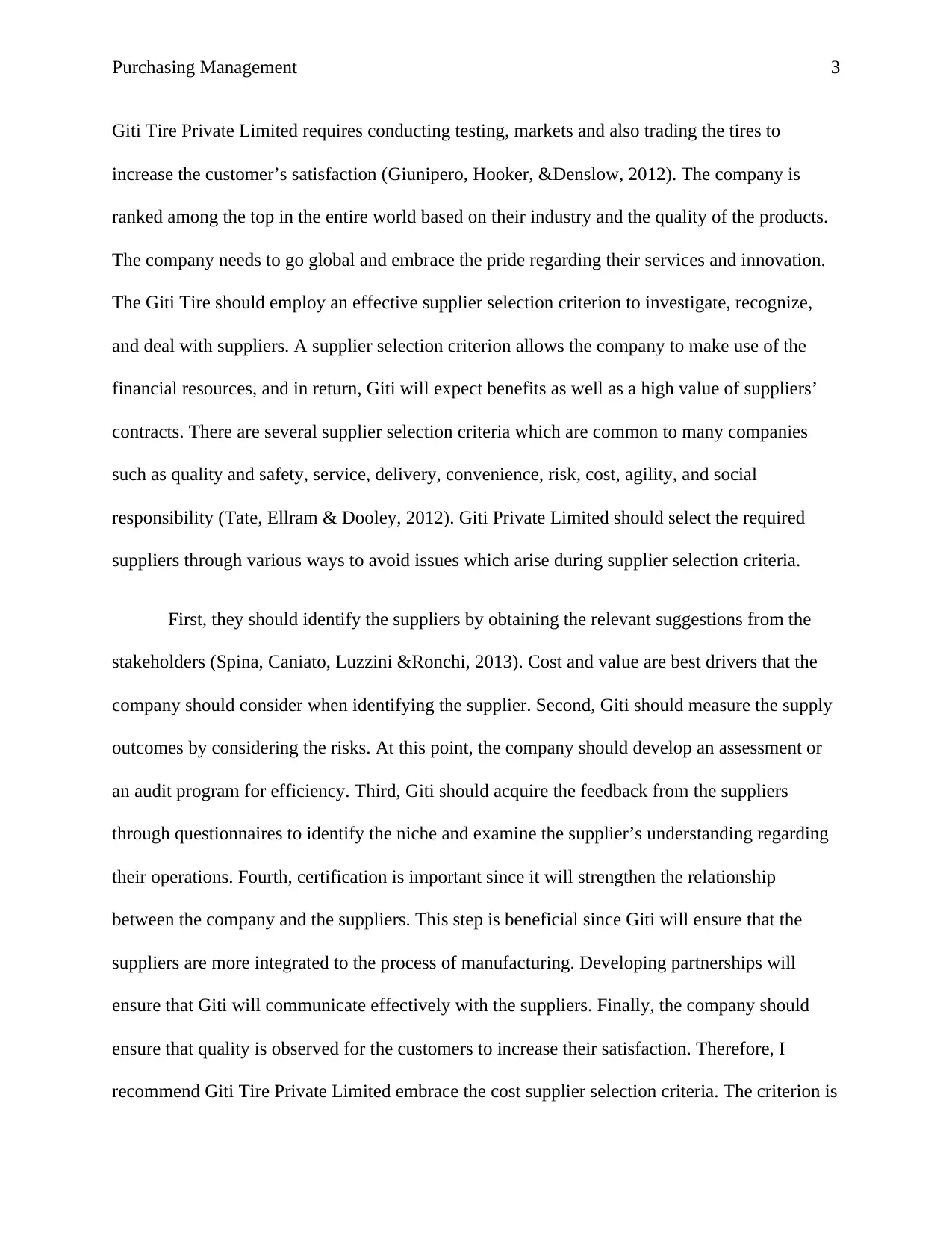
Purchasing Management 3
Giti Tire Private Limited requires conducting testing, markets and also trading the tires to
increase the customer’s satisfaction (Giunipero, Hooker, &Denslow, 2012). The company is
ranked among the top in the entire world based on their industry and the quality of the products.
The company needs to go global and embrace the pride regarding their services and innovation.
The Giti Tire should employ an effective supplier selection criterion to investigate, recognize,
and deal with suppliers. A supplier selection criterion allows the company to make use of the
financial resources, and in return, Giti will expect benefits as well as a high value of suppliers’
contracts. There are several supplier selection criteria which are common to many companies
such as quality and safety, service, delivery, convenience, risk, cost, agility, and social
responsibility (Tate, Ellram & Dooley, 2012). Giti Private Limited should select the required
suppliers through various ways to avoid issues which arise during supplier selection criteria.
First, they should identify the suppliers by obtaining the relevant suggestions from the
stakeholders (Spina, Caniato, Luzzini &Ronchi, 2013). Cost and value are best drivers that the
company should consider when identifying the supplier. Second, Giti should measure the supply
outcomes by considering the risks. At this point, the company should develop an assessment or
an audit program for efficiency. Third, Giti should acquire the feedback from the suppliers
through questionnaires to identify the niche and examine the supplier’s understanding regarding
their operations. Fourth, certification is important since it will strengthen the relationship
between the company and the suppliers. This step is beneficial since Giti will ensure that the
suppliers are more integrated to the process of manufacturing. Developing partnerships will
ensure that Giti will communicate effectively with the suppliers. Finally, the company should
ensure that quality is observed for the customers to increase their satisfaction. Therefore, I
recommend Giti Tire Private Limited embrace the cost supplier selection criteria. The criterion is
Giti Tire Private Limited requires conducting testing, markets and also trading the tires to
increase the customer’s satisfaction (Giunipero, Hooker, &Denslow, 2012). The company is
ranked among the top in the entire world based on their industry and the quality of the products.
The company needs to go global and embrace the pride regarding their services and innovation.
The Giti Tire should employ an effective supplier selection criterion to investigate, recognize,
and deal with suppliers. A supplier selection criterion allows the company to make use of the
financial resources, and in return, Giti will expect benefits as well as a high value of suppliers’
contracts. There are several supplier selection criteria which are common to many companies
such as quality and safety, service, delivery, convenience, risk, cost, agility, and social
responsibility (Tate, Ellram & Dooley, 2012). Giti Private Limited should select the required
suppliers through various ways to avoid issues which arise during supplier selection criteria.
First, they should identify the suppliers by obtaining the relevant suggestions from the
stakeholders (Spina, Caniato, Luzzini &Ronchi, 2013). Cost and value are best drivers that the
company should consider when identifying the supplier. Second, Giti should measure the supply
outcomes by considering the risks. At this point, the company should develop an assessment or
an audit program for efficiency. Third, Giti should acquire the feedback from the suppliers
through questionnaires to identify the niche and examine the supplier’s understanding regarding
their operations. Fourth, certification is important since it will strengthen the relationship
between the company and the suppliers. This step is beneficial since Giti will ensure that the
suppliers are more integrated to the process of manufacturing. Developing partnerships will
ensure that Giti will communicate effectively with the suppliers. Finally, the company should
ensure that quality is observed for the customers to increase their satisfaction. Therefore, I
recommend Giti Tire Private Limited embrace the cost supplier selection criteria. The criterion is
⊘ This is a preview!⊘
Do you want full access?
Subscribe today to unlock all pages.

Trusted by 1+ million students worldwide
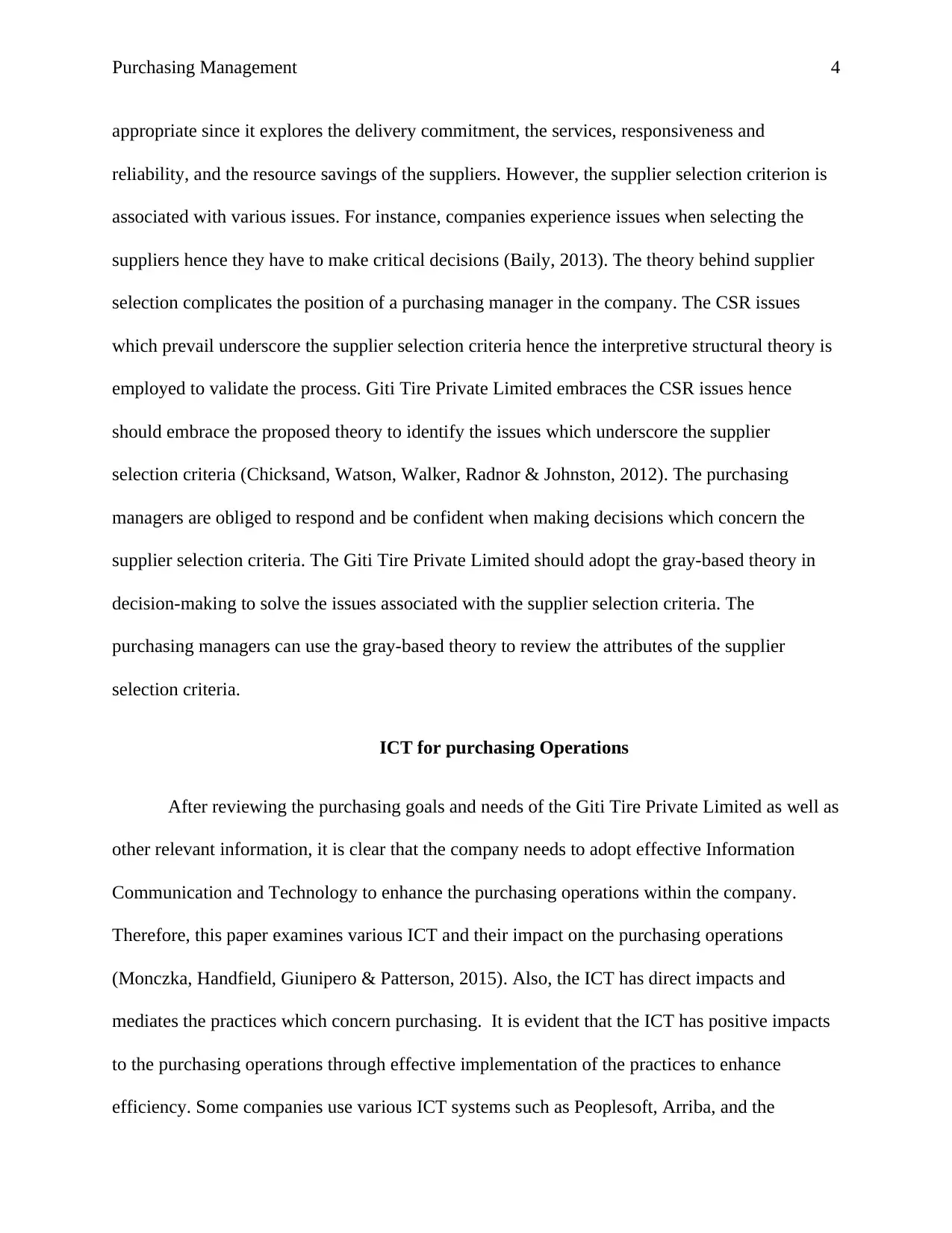
Purchasing Management 4
appropriate since it explores the delivery commitment, the services, responsiveness and
reliability, and the resource savings of the suppliers. However, the supplier selection criterion is
associated with various issues. For instance, companies experience issues when selecting the
suppliers hence they have to make critical decisions (Baily, 2013). The theory behind supplier
selection complicates the position of a purchasing manager in the company. The CSR issues
which prevail underscore the supplier selection criteria hence the interpretive structural theory is
employed to validate the process. Giti Tire Private Limited embraces the CSR issues hence
should embrace the proposed theory to identify the issues which underscore the supplier
selection criteria (Chicksand, Watson, Walker, Radnor & Johnston, 2012). The purchasing
managers are obliged to respond and be confident when making decisions which concern the
supplier selection criteria. The Giti Tire Private Limited should adopt the gray-based theory in
decision-making to solve the issues associated with the supplier selection criteria. The
purchasing managers can use the gray-based theory to review the attributes of the supplier
selection criteria.
ICT for purchasing Operations
After reviewing the purchasing goals and needs of the Giti Tire Private Limited as well as
other relevant information, it is clear that the company needs to adopt effective Information
Communication and Technology to enhance the purchasing operations within the company.
Therefore, this paper examines various ICT and their impact on the purchasing operations
(Monczka, Handfield, Giunipero & Patterson, 2015). Also, the ICT has direct impacts and
mediates the practices which concern purchasing. It is evident that the ICT has positive impacts
to the purchasing operations through effective implementation of the practices to enhance
efficiency. Some companies use various ICT systems such as Peoplesoft, Arriba, and the
appropriate since it explores the delivery commitment, the services, responsiveness and
reliability, and the resource savings of the suppliers. However, the supplier selection criterion is
associated with various issues. For instance, companies experience issues when selecting the
suppliers hence they have to make critical decisions (Baily, 2013). The theory behind supplier
selection complicates the position of a purchasing manager in the company. The CSR issues
which prevail underscore the supplier selection criteria hence the interpretive structural theory is
employed to validate the process. Giti Tire Private Limited embraces the CSR issues hence
should embrace the proposed theory to identify the issues which underscore the supplier
selection criteria (Chicksand, Watson, Walker, Radnor & Johnston, 2012). The purchasing
managers are obliged to respond and be confident when making decisions which concern the
supplier selection criteria. The Giti Tire Private Limited should adopt the gray-based theory in
decision-making to solve the issues associated with the supplier selection criteria. The
purchasing managers can use the gray-based theory to review the attributes of the supplier
selection criteria.
ICT for purchasing Operations
After reviewing the purchasing goals and needs of the Giti Tire Private Limited as well as
other relevant information, it is clear that the company needs to adopt effective Information
Communication and Technology to enhance the purchasing operations within the company.
Therefore, this paper examines various ICT and their impact on the purchasing operations
(Monczka, Handfield, Giunipero & Patterson, 2015). Also, the ICT has direct impacts and
mediates the practices which concern purchasing. It is evident that the ICT has positive impacts
to the purchasing operations through effective implementation of the practices to enhance
efficiency. Some companies use various ICT systems such as Peoplesoft, Arriba, and the
Paraphrase This Document
Need a fresh take? Get an instant paraphrase of this document with our AI Paraphraser

Purchasing Management 5
Commerce One as software. The software assists in streamlining the purchasing operations
hence effective communication is facilitated within the organization. Some of the outlined
software contains the databases which ensure the operations are accurate and timely. I also
recommend the Giti Tire Private Limited to adopt the e-sourcing equipment to cope with the
changes and trends in the supply chain (Arabzad, Kamali, Naji & Ghorbani, 2013). With the help
of the current ICT, the company will develop a better visibility for the purchasing operations as
well as the supply chain. This is because the company will have more power to control the
manufacturing activities hence coping with the stiff competition. The management of the supply
chain will be simplified using the ICT. Also, Giti Tire Private Limited will maintain and increase
the satisfaction of the customers.
Therefore, there are techniques which I recommend for the Giti Tire Private Limited; to
integrate the modern ICT into the company hence the management of the supply chain will be
enhanced. First, the computerized tracking and shipping will help the company simplify the
operations as well as reduce the errors which may arise. This step will help Giti consolidate the
supply chain elements; hence the information will be well monitored and tracked. At some point,
the ICT will help to enhance the experiences of the customers since the shipping errors are
minimized (Gelderman, Semeijn & de Bruijn, 2015). The Radio Frequency Identification is a
type of ICT which would be effective for the Giti Tire Private Limited since it has uncountable
advantages to the organization. This type of ICT will help the company detect the anomalies and
allow the employees to take caution to correct the mistakes. In simple words, the company will
exercise full control as they remove the anomalies and also, the operating costs are minimized
(Luzzini, Caniato, Ronchi & Spina, 2012). The company would also use the social media as a
type of ICT to restructure the supply chain. The social media will allow the company to achieve
Commerce One as software. The software assists in streamlining the purchasing operations
hence effective communication is facilitated within the organization. Some of the outlined
software contains the databases which ensure the operations are accurate and timely. I also
recommend the Giti Tire Private Limited to adopt the e-sourcing equipment to cope with the
changes and trends in the supply chain (Arabzad, Kamali, Naji & Ghorbani, 2013). With the help
of the current ICT, the company will develop a better visibility for the purchasing operations as
well as the supply chain. This is because the company will have more power to control the
manufacturing activities hence coping with the stiff competition. The management of the supply
chain will be simplified using the ICT. Also, Giti Tire Private Limited will maintain and increase
the satisfaction of the customers.
Therefore, there are techniques which I recommend for the Giti Tire Private Limited; to
integrate the modern ICT into the company hence the management of the supply chain will be
enhanced. First, the computerized tracking and shipping will help the company simplify the
operations as well as reduce the errors which may arise. This step will help Giti consolidate the
supply chain elements; hence the information will be well monitored and tracked. At some point,
the ICT will help to enhance the experiences of the customers since the shipping errors are
minimized (Gelderman, Semeijn & de Bruijn, 2015). The Radio Frequency Identification is a
type of ICT which would be effective for the Giti Tire Private Limited since it has uncountable
advantages to the organization. This type of ICT will help the company detect the anomalies and
allow the employees to take caution to correct the mistakes. In simple words, the company will
exercise full control as they remove the anomalies and also, the operating costs are minimized
(Luzzini, Caniato, Ronchi & Spina, 2012). The company would also use the social media as a
type of ICT to restructure the supply chain. The social media will allow the company to achieve
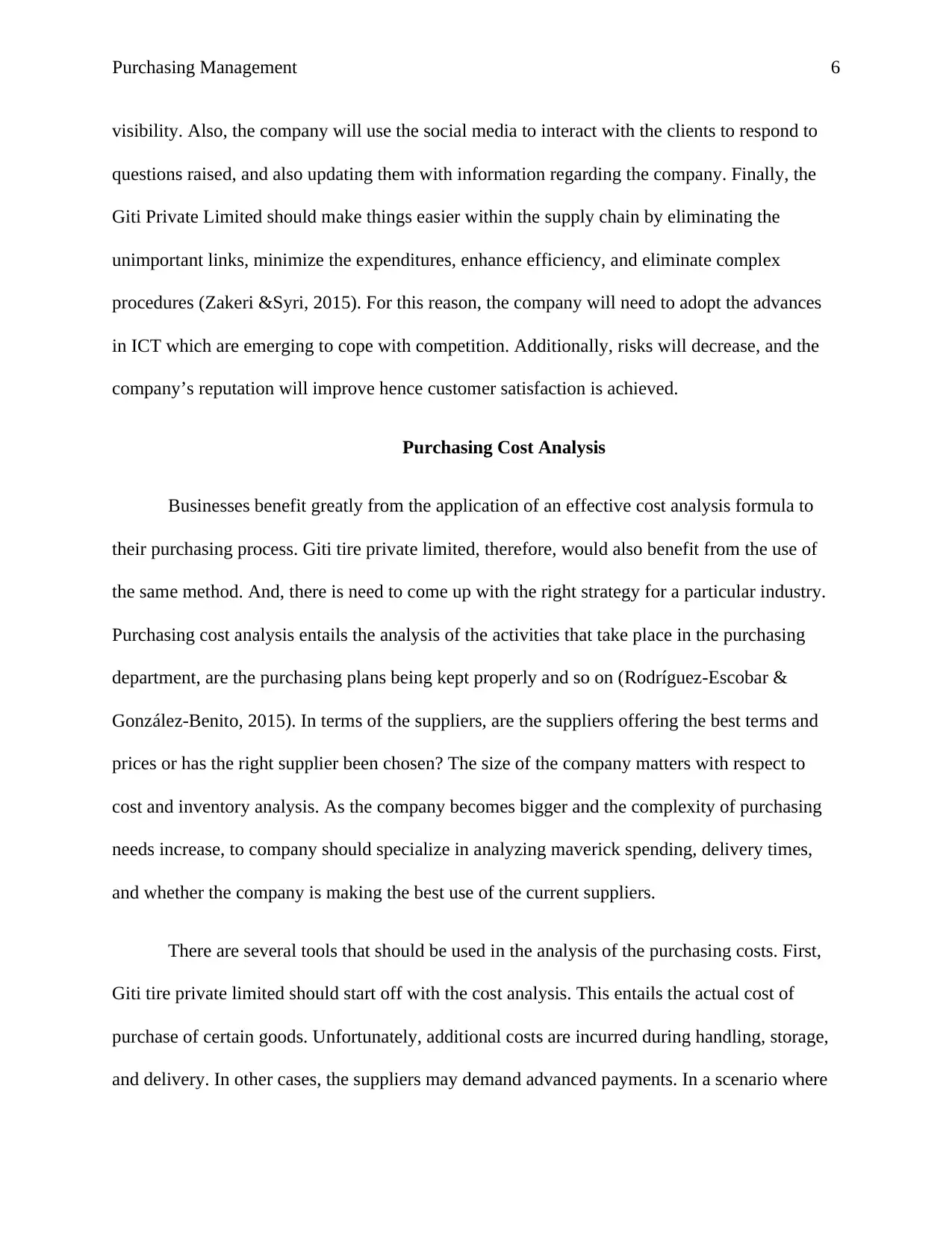
Purchasing Management 6
visibility. Also, the company will use the social media to interact with the clients to respond to
questions raised, and also updating them with information regarding the company. Finally, the
Giti Private Limited should make things easier within the supply chain by eliminating the
unimportant links, minimize the expenditures, enhance efficiency, and eliminate complex
procedures (Zakeri &Syri, 2015). For this reason, the company will need to adopt the advances
in ICT which are emerging to cope with competition. Additionally, risks will decrease, and the
company’s reputation will improve hence customer satisfaction is achieved.
Purchasing Cost Analysis
Businesses benefit greatly from the application of an effective cost analysis formula to
their purchasing process. Giti tire private limited, therefore, would also benefit from the use of
the same method. And, there is need to come up with the right strategy for a particular industry.
Purchasing cost analysis entails the analysis of the activities that take place in the purchasing
department, are the purchasing plans being kept properly and so on (Rodríguez-Escobar &
González-Benito, 2015). In terms of the suppliers, are the suppliers offering the best terms and
prices or has the right supplier been chosen? The size of the company matters with respect to
cost and inventory analysis. As the company becomes bigger and the complexity of purchasing
needs increase, to company should specialize in analyzing maverick spending, delivery times,
and whether the company is making the best use of the current suppliers.
There are several tools that should be used in the analysis of the purchasing costs. First,
Giti tire private limited should start off with the cost analysis. This entails the actual cost of
purchase of certain goods. Unfortunately, additional costs are incurred during handling, storage,
and delivery. In other cases, the suppliers may demand advanced payments. In a scenario where
visibility. Also, the company will use the social media to interact with the clients to respond to
questions raised, and also updating them with information regarding the company. Finally, the
Giti Private Limited should make things easier within the supply chain by eliminating the
unimportant links, minimize the expenditures, enhance efficiency, and eliminate complex
procedures (Zakeri &Syri, 2015). For this reason, the company will need to adopt the advances
in ICT which are emerging to cope with competition. Additionally, risks will decrease, and the
company’s reputation will improve hence customer satisfaction is achieved.
Purchasing Cost Analysis
Businesses benefit greatly from the application of an effective cost analysis formula to
their purchasing process. Giti tire private limited, therefore, would also benefit from the use of
the same method. And, there is need to come up with the right strategy for a particular industry.
Purchasing cost analysis entails the analysis of the activities that take place in the purchasing
department, are the purchasing plans being kept properly and so on (Rodríguez-Escobar &
González-Benito, 2015). In terms of the suppliers, are the suppliers offering the best terms and
prices or has the right supplier been chosen? The size of the company matters with respect to
cost and inventory analysis. As the company becomes bigger and the complexity of purchasing
needs increase, to company should specialize in analyzing maverick spending, delivery times,
and whether the company is making the best use of the current suppliers.
There are several tools that should be used in the analysis of the purchasing costs. First,
Giti tire private limited should start off with the cost analysis. This entails the actual cost of
purchase of certain goods. Unfortunately, additional costs are incurred during handling, storage,
and delivery. In other cases, the suppliers may demand advanced payments. In a scenario where
⊘ This is a preview!⊘
Do you want full access?
Subscribe today to unlock all pages.

Trusted by 1+ million students worldwide
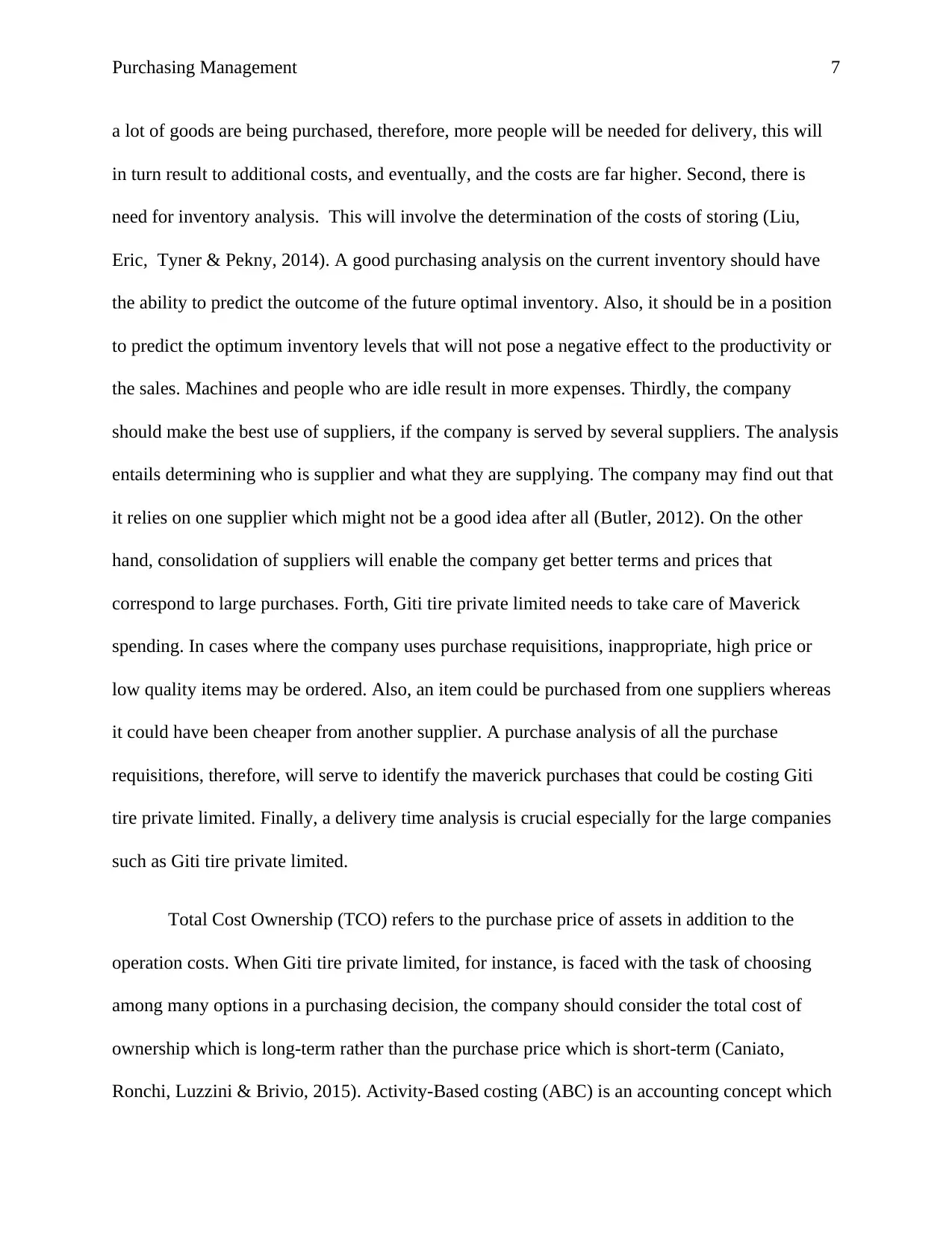
Purchasing Management 7
a lot of goods are being purchased, therefore, more people will be needed for delivery, this will
in turn result to additional costs, and eventually, and the costs are far higher. Second, there is
need for inventory analysis. This will involve the determination of the costs of storing (Liu,
Eric, Tyner & Pekny, 2014). A good purchasing analysis on the current inventory should have
the ability to predict the outcome of the future optimal inventory. Also, it should be in a position
to predict the optimum inventory levels that will not pose a negative effect to the productivity or
the sales. Machines and people who are idle result in more expenses. Thirdly, the company
should make the best use of suppliers, if the company is served by several suppliers. The analysis
entails determining who is supplier and what they are supplying. The company may find out that
it relies on one supplier which might not be a good idea after all (Butler, 2012). On the other
hand, consolidation of suppliers will enable the company get better terms and prices that
correspond to large purchases. Forth, Giti tire private limited needs to take care of Maverick
spending. In cases where the company uses purchase requisitions, inappropriate, high price or
low quality items may be ordered. Also, an item could be purchased from one suppliers whereas
it could have been cheaper from another supplier. A purchase analysis of all the purchase
requisitions, therefore, will serve to identify the maverick purchases that could be costing Giti
tire private limited. Finally, a delivery time analysis is crucial especially for the large companies
such as Giti tire private limited.
Total Cost Ownership (TCO) refers to the purchase price of assets in addition to the
operation costs. When Giti tire private limited, for instance, is faced with the task of choosing
among many options in a purchasing decision, the company should consider the total cost of
ownership which is long-term rather than the purchase price which is short-term (Caniato,
Ronchi, Luzzini & Brivio, 2015). Activity-Based costing (ABC) is an accounting concept which
a lot of goods are being purchased, therefore, more people will be needed for delivery, this will
in turn result to additional costs, and eventually, and the costs are far higher. Second, there is
need for inventory analysis. This will involve the determination of the costs of storing (Liu,
Eric, Tyner & Pekny, 2014). A good purchasing analysis on the current inventory should have
the ability to predict the outcome of the future optimal inventory. Also, it should be in a position
to predict the optimum inventory levels that will not pose a negative effect to the productivity or
the sales. Machines and people who are idle result in more expenses. Thirdly, the company
should make the best use of suppliers, if the company is served by several suppliers. The analysis
entails determining who is supplier and what they are supplying. The company may find out that
it relies on one supplier which might not be a good idea after all (Butler, 2012). On the other
hand, consolidation of suppliers will enable the company get better terms and prices that
correspond to large purchases. Forth, Giti tire private limited needs to take care of Maverick
spending. In cases where the company uses purchase requisitions, inappropriate, high price or
low quality items may be ordered. Also, an item could be purchased from one suppliers whereas
it could have been cheaper from another supplier. A purchase analysis of all the purchase
requisitions, therefore, will serve to identify the maverick purchases that could be costing Giti
tire private limited. Finally, a delivery time analysis is crucial especially for the large companies
such as Giti tire private limited.
Total Cost Ownership (TCO) refers to the purchase price of assets in addition to the
operation costs. When Giti tire private limited, for instance, is faced with the task of choosing
among many options in a purchasing decision, the company should consider the total cost of
ownership which is long-term rather than the purchase price which is short-term (Caniato,
Ronchi, Luzzini & Brivio, 2015). Activity-Based costing (ABC) is an accounting concept which
Paraphrase This Document
Need a fresh take? Get an instant paraphrase of this document with our AI Paraphraser
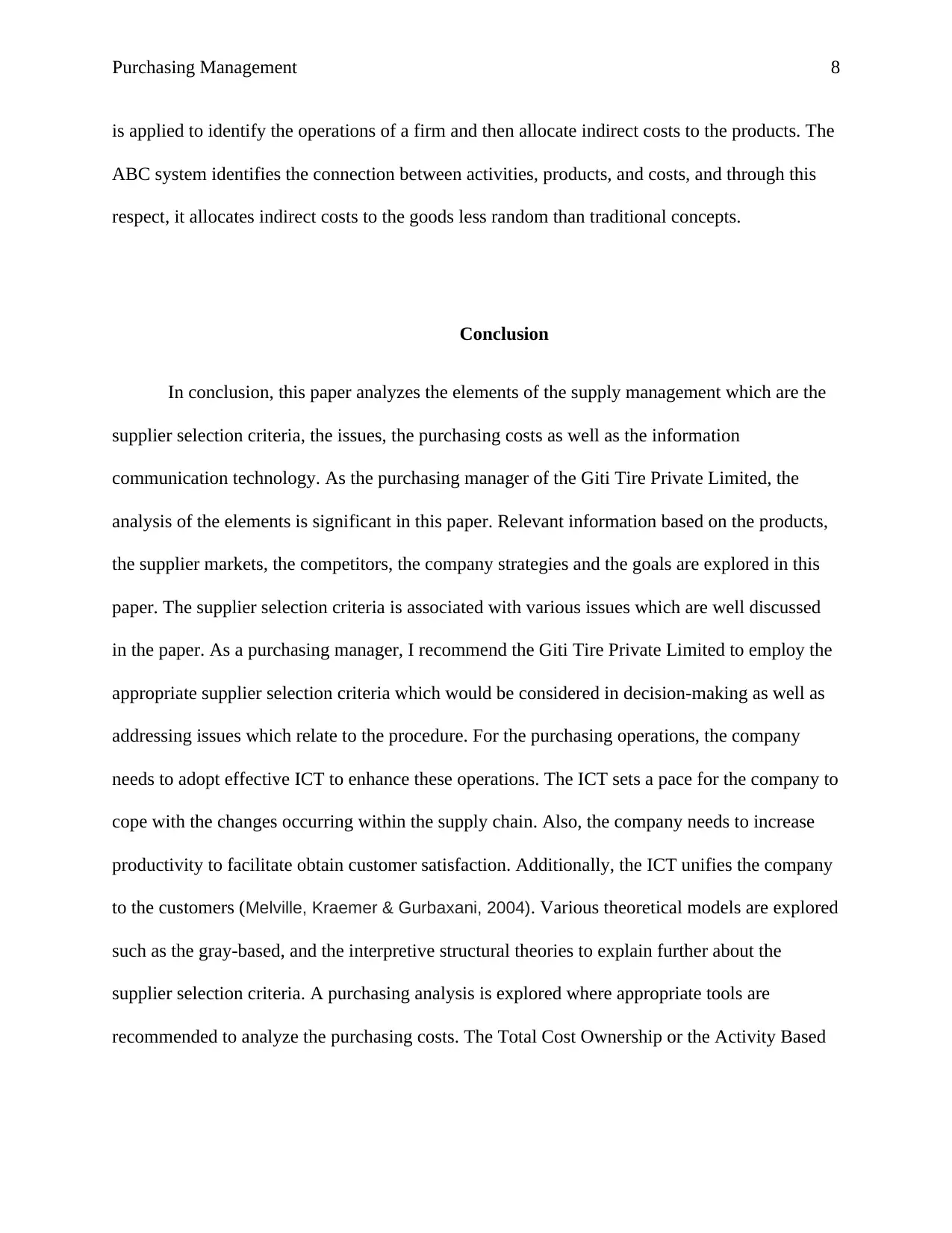
Purchasing Management 8
is applied to identify the operations of a firm and then allocate indirect costs to the products. The
ABC system identifies the connection between activities, products, and costs, and through this
respect, it allocates indirect costs to the goods less random than traditional concepts.
Conclusion
In conclusion, this paper analyzes the elements of the supply management which are the
supplier selection criteria, the issues, the purchasing costs as well as the information
communication technology. As the purchasing manager of the Giti Tire Private Limited, the
analysis of the elements is significant in this paper. Relevant information based on the products,
the supplier markets, the competitors, the company strategies and the goals are explored in this
paper. The supplier selection criteria is associated with various issues which are well discussed
in the paper. As a purchasing manager, I recommend the Giti Tire Private Limited to employ the
appropriate supplier selection criteria which would be considered in decision-making as well as
addressing issues which relate to the procedure. For the purchasing operations, the company
needs to adopt effective ICT to enhance these operations. The ICT sets a pace for the company to
cope with the changes occurring within the supply chain. Also, the company needs to increase
productivity to facilitate obtain customer satisfaction. Additionally, the ICT unifies the company
to the customers (Melville, Kraemer & Gurbaxani, 2004). Various theoretical models are explored
such as the gray-based, and the interpretive structural theories to explain further about the
supplier selection criteria. A purchasing analysis is explored where appropriate tools are
recommended to analyze the purchasing costs. The Total Cost Ownership or the Activity Based
is applied to identify the operations of a firm and then allocate indirect costs to the products. The
ABC system identifies the connection between activities, products, and costs, and through this
respect, it allocates indirect costs to the goods less random than traditional concepts.
Conclusion
In conclusion, this paper analyzes the elements of the supply management which are the
supplier selection criteria, the issues, the purchasing costs as well as the information
communication technology. As the purchasing manager of the Giti Tire Private Limited, the
analysis of the elements is significant in this paper. Relevant information based on the products,
the supplier markets, the competitors, the company strategies and the goals are explored in this
paper. The supplier selection criteria is associated with various issues which are well discussed
in the paper. As a purchasing manager, I recommend the Giti Tire Private Limited to employ the
appropriate supplier selection criteria which would be considered in decision-making as well as
addressing issues which relate to the procedure. For the purchasing operations, the company
needs to adopt effective ICT to enhance these operations. The ICT sets a pace for the company to
cope with the changes occurring within the supply chain. Also, the company needs to increase
productivity to facilitate obtain customer satisfaction. Additionally, the ICT unifies the company
to the customers (Melville, Kraemer & Gurbaxani, 2004). Various theoretical models are explored
such as the gray-based, and the interpretive structural theories to explain further about the
supplier selection criteria. A purchasing analysis is explored where appropriate tools are
recommended to analyze the purchasing costs. The Total Cost Ownership or the Activity Based

Purchasing Management 9
Costing is discussed as well. This paper explores the elements exhaustively regarding the Giti
Tire Private Limited which is a type of a manufacturing company.
Costing is discussed as well. This paper explores the elements exhaustively regarding the Giti
Tire Private Limited which is a type of a manufacturing company.
⊘ This is a preview!⊘
Do you want full access?
Subscribe today to unlock all pages.

Trusted by 1+ million students worldwide
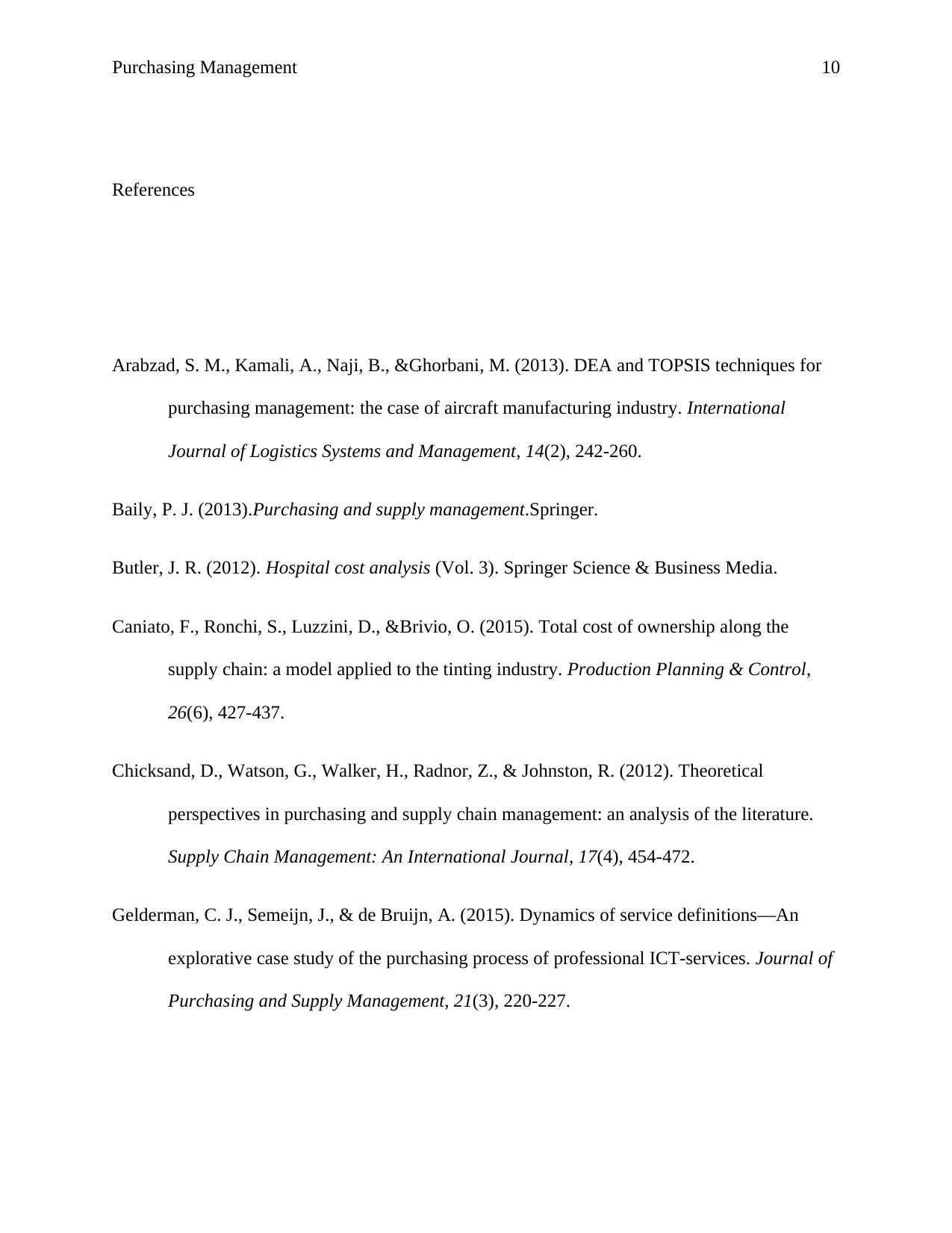
Purchasing Management 10
References
Arabzad, S. M., Kamali, A., Naji, B., &Ghorbani, M. (2013). DEA and TOPSIS techniques for
purchasing management: the case of aircraft manufacturing industry. International
Journal of Logistics Systems and Management, 14(2), 242-260.
Baily, P. J. (2013).Purchasing and supply management.Springer.
Butler, J. R. (2012). Hospital cost analysis (Vol. 3). Springer Science & Business Media.
Caniato, F., Ronchi, S., Luzzini, D., &Brivio, O. (2015). Total cost of ownership along the
supply chain: a model applied to the tinting industry. Production Planning & Control,
26(6), 427-437.
Chicksand, D., Watson, G., Walker, H., Radnor, Z., & Johnston, R. (2012). Theoretical
perspectives in purchasing and supply chain management: an analysis of the literature.
Supply Chain Management: An International Journal, 17(4), 454-472.
Gelderman, C. J., Semeijn, J., & de Bruijn, A. (2015). Dynamics of service definitions—An
explorative case study of the purchasing process of professional ICT-services. Journal of
Purchasing and Supply Management, 21(3), 220-227.
References
Arabzad, S. M., Kamali, A., Naji, B., &Ghorbani, M. (2013). DEA and TOPSIS techniques for
purchasing management: the case of aircraft manufacturing industry. International
Journal of Logistics Systems and Management, 14(2), 242-260.
Baily, P. J. (2013).Purchasing and supply management.Springer.
Butler, J. R. (2012). Hospital cost analysis (Vol. 3). Springer Science & Business Media.
Caniato, F., Ronchi, S., Luzzini, D., &Brivio, O. (2015). Total cost of ownership along the
supply chain: a model applied to the tinting industry. Production Planning & Control,
26(6), 427-437.
Chicksand, D., Watson, G., Walker, H., Radnor, Z., & Johnston, R. (2012). Theoretical
perspectives in purchasing and supply chain management: an analysis of the literature.
Supply Chain Management: An International Journal, 17(4), 454-472.
Gelderman, C. J., Semeijn, J., & de Bruijn, A. (2015). Dynamics of service definitions—An
explorative case study of the purchasing process of professional ICT-services. Journal of
Purchasing and Supply Management, 21(3), 220-227.
Paraphrase This Document
Need a fresh take? Get an instant paraphrase of this document with our AI Paraphraser

Purchasing Management 11
Giunipero, L. C., Hooker, R. E., &Denslow, D. (2012). Purchasing and supply management
sustainability: Drivers and barriers. Journal of Purchasing and Supply Management,
18(4), 258-269.
Liu, X., Eric, G. O., Tyner, W. E., &Pekny, J. F. (2014).Purchasing vs. leasing: A benefit-cost
analysis of residential solar PV panel use in California.Renewable Energy, 66, 770-774.
Luzzini, D., Caniato, F., Ronchi, S., & Spina, G. (2012). A transaction costs approach to
purchasing portfolio management. International Journal of Operations & Production
Management, 32(9), 1015-1042.
Melville, N., Kraemer, K., & Gurbaxani, V. (2004). Information technology and organizational
performance: An integrative model of IT business value. MIS quarterly, 28(2), 283-322.
Miemczyk, J., Johnsen, T. E., &Macquet, M. (2012). Sustainable purchasing and supply
management: a structured literature review of definitions and measures at the dyad, chain
and network levels. Supply Chain Management: An International Journal, 17(5), 478-
496.
Monczka, R. M., Handfield, R. B., Giunipero, L. C., & Patterson, J. L. (2015).Purchasing and
supply chain management. Cengage Learning.
Rodríguez-Escobar, J. A., & González-Benito, J. (2015).The role of information technology in
purchasing function.Journal of Business & Industrial Marketing, 30(5), 498-510.
Spina, G., Caniato, F., Luzzini, D., &Ronchi, S. (2013). Past, present and future trends of
purchasing and supply management: An extensive literature review. Industrial Marketing
Management, 42(8), 1202-1212.
Giunipero, L. C., Hooker, R. E., &Denslow, D. (2012). Purchasing and supply management
sustainability: Drivers and barriers. Journal of Purchasing and Supply Management,
18(4), 258-269.
Liu, X., Eric, G. O., Tyner, W. E., &Pekny, J. F. (2014).Purchasing vs. leasing: A benefit-cost
analysis of residential solar PV panel use in California.Renewable Energy, 66, 770-774.
Luzzini, D., Caniato, F., Ronchi, S., & Spina, G. (2012). A transaction costs approach to
purchasing portfolio management. International Journal of Operations & Production
Management, 32(9), 1015-1042.
Melville, N., Kraemer, K., & Gurbaxani, V. (2004). Information technology and organizational
performance: An integrative model of IT business value. MIS quarterly, 28(2), 283-322.
Miemczyk, J., Johnsen, T. E., &Macquet, M. (2012). Sustainable purchasing and supply
management: a structured literature review of definitions and measures at the dyad, chain
and network levels. Supply Chain Management: An International Journal, 17(5), 478-
496.
Monczka, R. M., Handfield, R. B., Giunipero, L. C., & Patterson, J. L. (2015).Purchasing and
supply chain management. Cengage Learning.
Rodríguez-Escobar, J. A., & González-Benito, J. (2015).The role of information technology in
purchasing function.Journal of Business & Industrial Marketing, 30(5), 498-510.
Spina, G., Caniato, F., Luzzini, D., &Ronchi, S. (2013). Past, present and future trends of
purchasing and supply management: An extensive literature review. Industrial Marketing
Management, 42(8), 1202-1212.
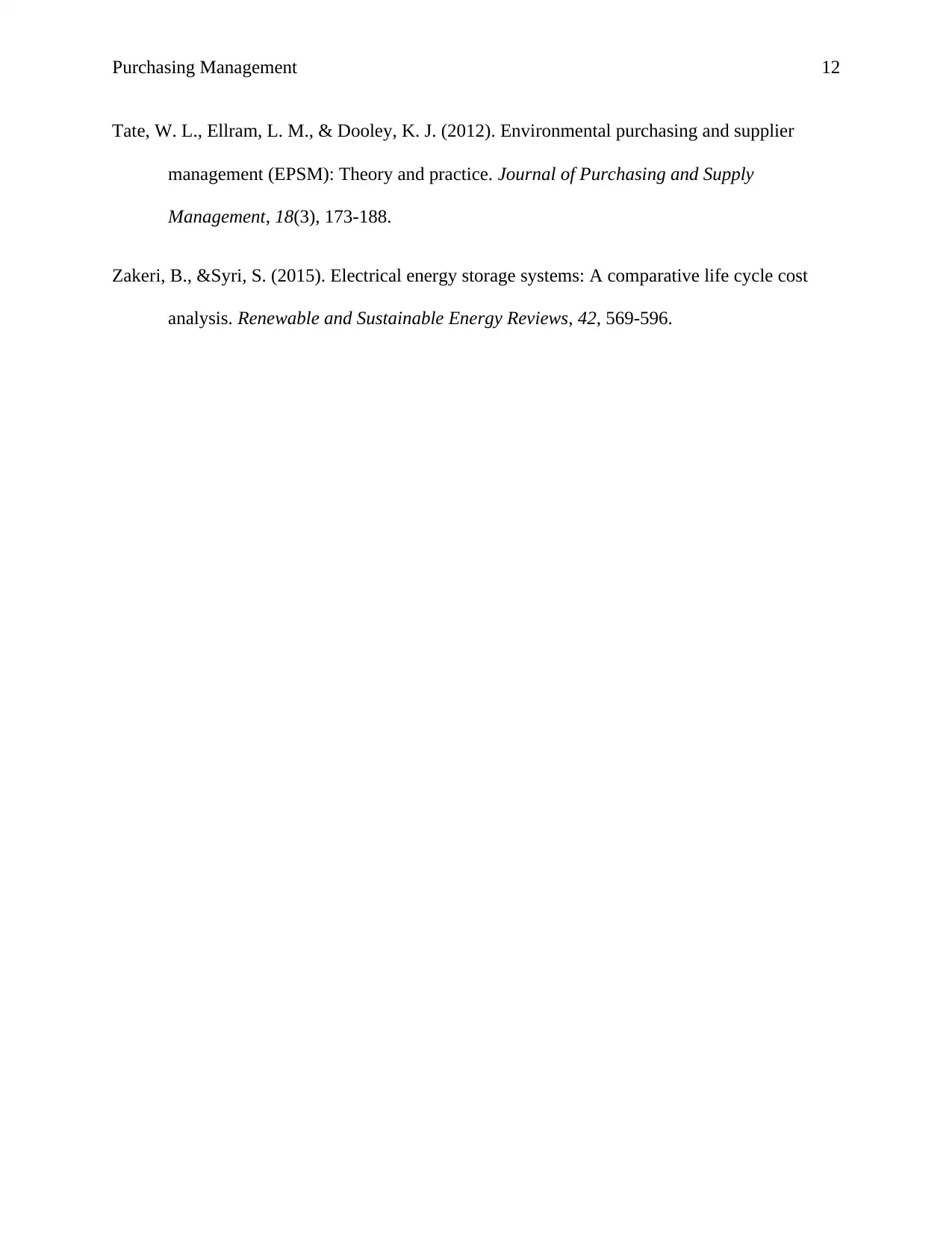
Purchasing Management 12
Tate, W. L., Ellram, L. M., & Dooley, K. J. (2012). Environmental purchasing and supplier
management (EPSM): Theory and practice. Journal of Purchasing and Supply
Management, 18(3), 173-188.
Zakeri, B., &Syri, S. (2015). Electrical energy storage systems: A comparative life cycle cost
analysis. Renewable and Sustainable Energy Reviews, 42, 569-596.
Tate, W. L., Ellram, L. M., & Dooley, K. J. (2012). Environmental purchasing and supplier
management (EPSM): Theory and practice. Journal of Purchasing and Supply
Management, 18(3), 173-188.
Zakeri, B., &Syri, S. (2015). Electrical energy storage systems: A comparative life cycle cost
analysis. Renewable and Sustainable Energy Reviews, 42, 569-596.
⊘ This is a preview!⊘
Do you want full access?
Subscribe today to unlock all pages.

Trusted by 1+ million students worldwide
1 out of 12
Related Documents
Your All-in-One AI-Powered Toolkit for Academic Success.
+13062052269
info@desklib.com
Available 24*7 on WhatsApp / Email
![[object Object]](/_next/static/media/star-bottom.7253800d.svg)
Unlock your academic potential
Copyright © 2020–2025 A2Z Services. All Rights Reserved. Developed and managed by ZUCOL.





